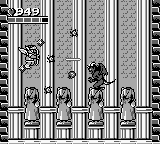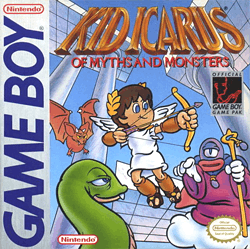Kid Icarus: Of Myths and Monsters
| Kid Icarus: Of Myths and Monsters | |
|---|---|
|
North American box art | |
| Developer(s) |
Nintendo Tose |
| Publisher(s) | Nintendo |
| Producer(s) | Gunpei Yokoi |
| Designer(s) | Masafumi Sakashita |
| Series | Kid Icarus[*] |
| Platform(s) | Game Boy, Nintendo 3DS |
| Release date(s) |
Game Boy 3DS Virtual Console[1] |
| Genre(s) | Action, platforming |
| Mode(s) | Single-player |
Kid Icarus: Of Myths and Monsters is an action platform video game for the Game Boy. It was developed by Nintendo and Tose and published by Nintendo, and is the sequel to Kid Icarus on the Nintendo Entertainment System. The game was released in North America on November 5, 1991, and in Europe on May 21, 1992, but not in Japan until on February 8, 2012 via the 3DS Virtual Console, where it retains its English title. Then it was re-released in Europe on March 8, 2012, and in North America on July 19, 2012. The story of Kid Icarus: Of Myths and Monsters is influenced by Greek mythology, and follows the angel soldier Pit on his quest for three sacred treasures. His objective is to defeat the demon Orcos, who has invaded the kingdom of Angel Land. The game features the core gameplay mechanics of its predecessor. Players explore two-dimensional environments while collecting items and fighting monsters. Kid Icarus: Of Myths and Monsters was named the 18th best Game Boy game by Nintendo Power, and critics commended it for its gameplay, graphics and music.
Gameplay

Kid Icarus: Of Myths and Monsters is an action platform game. It largely retains the gameplay of its predecessor, Kid Icarus for the Nintendo Entertainment System (NES). The player controls the young angel Pit, whose main weapon is a bow with an unlimited supply of arrows. The game's two-dimensional levels contain collectable items and obstacles such as enemies and traps.[3] Pit's objective is to reach the end of three stages – the underworld tower, the overworld and the sky world tower – each of which is separated into three areas and a labyrinthine fortress.[4] Upon completing one of a stage's areas, the player has the option of saving their progress, and Pit's health bar may be expanded if he has defeated enough enemies.[2][5]
Unlike in Kid Icarus, the game's levels scroll freely in all four directions, which enables the player to explore previously visited environments. As an additional control feature, Pit can flap his wings in mid-air to slow his descent.[6] In each area, there are hidden doors that lead to eight different types of chambers.[7] In shops and black markets, the player may buy items such as healing potions in exchange for hearts, which are left behind by destroyed monsters.[2][7] Information centers provide hints, hot springs restore Pit's health, and bat chambers give the player an opportunity to earn extra hearts. Treasuries hold items that can be obtained in a game of chance.[7] In the sacred chamber, the god Zeus presents Pit with additional physical strength depending on the number of enemies defeated. The sacred training center has Pit take part in a test of endurance. His success will be awarded with one of three weapons, which will become active if his health is high enough: the protective crystals shield Pit from enemies, and the fire arrows and long bow increase the vertical and horizontal range of the arrows, respectively.[2] During the course of the game, the player must find and defeat guardian monsters in the fortresses to retrieve three sacred treasures – the Wings of Pegasus, the Silver Armor and the Light Arrows. These are special items, which grant Pit new abilities in the final stage, the sky palace.[2][4]
Plot
The game is set in the Greek mythological fantasy world Angel Land that is ruled by the goddess Palutena. Its story is detailed in the instruction booklet: Palutena has a nightmare, which a soothsayer interprets as a foreshadowing of an invasion by the demon Orcos and his minions. The goddess summons Pit – the leader of her army – and commands him to enter a special training that will give him the power to use Angel Land's three sacred treasures. To keep these safe from Orcos while Pit is on his mission, Palutena has them protected by three fortress guardians. After Pit has finished his training and defeated the guardians, the goddess equips him with the sacred treasures.[8] Orcos appears and turns Palutena to stone, but Pit defeats him and saves her, restoring peace to Angel Land. In the ending, Pit soars into the sky. As in the Greek myth of Icarus, he flies too close to the sun and loses his wings.[9]
Development and reception
Kid Icarus: Of Myths and Monsters was designed by Masafumi Sakashita, and developed by Nintendo in co-operation with the external company Tose.[10][11] It was released in North America in November 1991, and in Europe on May 21, 1992.[12][13] As such, it is one of the few first-party Nintendo games that were not published in Japan.[14] Kid Icarus: Of Myths and Monsters has been met with generally favorable reviews. A writer of the UK publication Nintendo Magazine System awarded it a score of 71 percent, and described it as a "fairly jolly adaptation of the NES platform game [that] provides the fun, but is now getting rather long in the tooth".[15] Joystiq's JC Fletcher thought that it "advances significantly beyond its predecessor", yet "remains unquestionably Kid Icarus, the same weird game about shooting snakes falling out of inverted clay pots".[6] A GamePro reviewer under the pseudonym "The Great McGillicuty" found the game's controls to be "precise and accurate", and gave its gameplay the magazine's maximum score of five points. He said that the "music sets the mood", and that the graphics were "fine in black-and-white", owing to its "large sprites and nice backgrounds".[3] IGN editor Audrey Drake called the game an "awesome sequel" that stood out to her because of its improvements over the gameplay of the original Kid Icarus. Although she found it to be "not as punishing ... and, perhaps, not as memorable" as the NES game, she thought that Kid Icarus: Of Myths and Monsters was "a solid title that has undeservedly been all-but-forgotten".[16] GameZone's David Sanchez believed that it "faithfully captured the magic of the first game", and demanded a digital re-release for the Nintendo 3DS handheld console.[17] Kid Icarus: Of Myths and Monsters was included in Nintendo Power's list of the 20 best Game Boy games, where it came in 18th place.[18] It remained the last installment in the Kid Icarus series in the USA for 21 years, until the 2012 3D shooter Kid Icarus: Uprising for the Nintendo 3DS.[19][20] The 3DS Virtual Console re-release was scored 8/10 in a NintendoLife review.[1]
References
- 1 2 3 "Kid Icarus: Of Myths and Monsters". NintendoLife. Retrieved 9 March 2012.
- 1 2 3 4 5 "The Items". Kid Icarus: Of Myths and Monsters Instruction Booklet. Nintendo of America. November 1991. pp. 13–20.
- 1 2 The Great McGillicuty (May 1992). "Pro Reviews – Kid Icarus: Of Myths and Monsters". GamePro. IDG Communications (34): 72.
- 1 2 "A Guide to Angel Land". Kid Icarus: Of Myths and Monsters Instruction Booklet. Nintendo of America. November 1991. pp. 11–12.
- ↑ "How to Play Kid Icarus". Kid Icarus: Of Myths and Monsters Instruction Booklet. Nintendo of America. November 1991. pp. 9–10.
- 1 2 Fletcher, JC (October 16, 2008). "Virtually Overlooked: Kid Icarus: Of Myths and Monsters". Joystiq. AOL Inc. Archived from the original on July 5, 2011. Retrieved July 5, 2011.
- 1 2 3 "Rooms". Kid Icarus: Of Myths and Monsters Instruction Booklet. Nintendo of America. November 1991. pp. 21–24.
- ↑ "The Tale of Kid Icarus". Kid Icarus: Of Myths and Monsters Instruction Booklet. Nintendo of America. November 1991. pp. 3–6.
- ↑ Thomas, Lucas M. (January 26, 2011). "You Don't Know Kid Icarus". IGN. IGN Entertainment, Inc. Retrieved July 5, 2011.
- ↑ "Classification Database – Kid Icarus: Of Myths and Monsters". Attorney-General's Department Classification Branch. July 9, 1997. Archived from the original on July 27, 2011. Retrieved July 27, 2011.
- ↑ "Interview Series 2 – 戦場よりIを込めて". Creators Station. Fellows Inc. Archived from the original on June 25, 2011. Retrieved June 25, 2011.
- ↑ "Classic System Games: Complete List" (PDF). Nintendo of America. Archived (PDF) from the original on December 21, 2010. Retrieved July 5, 2011.
- ↑ "Game Boy Pelilista" (in Finnish). Nintendo of Europe; Amo Oy. Archived from the original on October 24, 2007.
- ↑ Parish, Jeremy; Barnholt, Ray; Cifaldi, Frank; Kohler, Chris; (July 17, 2010). Retronauts Episode 96 (mp3). UGO Entertainment; Podtrac, Inc. Event occurs at 75:20. Retrieved July 6, 2011.
- ↑ "Game Boy Game Index". Nintendo Magazine System. EMAP Images Limited (1): 110. October 1992.
- ↑ Drake, Audrey (January 31, 2011). "Bringing the Game Boy to the 3DS". IGN. IGN Entertainment, Inc. Archived from the original on July 26, 2011. Retrieved July 26, 2011.
- ↑ Sanchez, David (June 5, 2011). "Top 10 Game Boy Games That Need the 3DS Treatment". GameZone. Intergi LLC. Archived from the original on July 26, 2011. Retrieved July 26, 2011.
- ↑ "Top 20 Games For Each Nintendo System". Nintendo Power. Future Publishing (231): 71. August 2008.
- ↑ McWhertor, Michael (July 12, 2010). "The New Kid Icarus May Explore Another Dimension: Multiplayer". Kotaku. Gawker Media. Archived from the original on July 5, 2011. Retrieved July 5, 2011.
- ↑ Gifford, Kevin (July 14, 2010). "More on The Making of Kid Icarus: Uprising". 1UP.com. UGO Entertainment. Archived from the original on July 5, 2011. Retrieved July 6, 2011.
